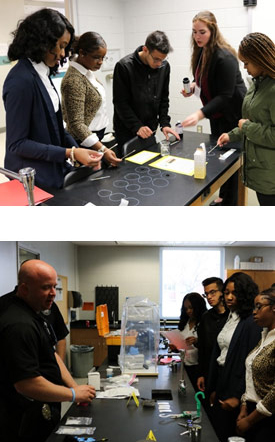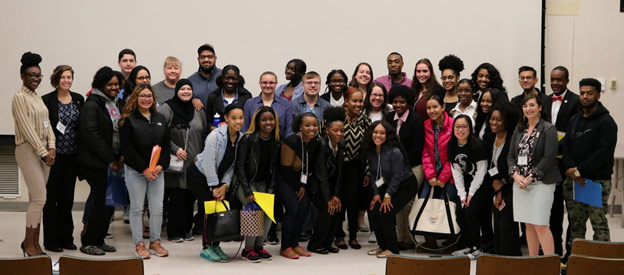Contact Us
To provide feedback on the Community Policing Dispatch, e-mail the editorial board at CPDispatch@usdoj.gov.
To obtain details on COPS Office programs, publications, and resources, contact the COPS Office Response Center at 800-421-6770 or AskCopsRC@usdoj.gov

U.S. Department of Justice
Office of Community Oriented Policing Services
Washington, DC 20530
 On Saturday, April 21, 2018, Delaware State University (DSU)—a historically Black University (HBCU)—hosted the first Forensic Science & Investigation Day in attempts to build a bridge between high school and university students, and police and to promote student interest in science, technology, engineering, and math (STEM) positions within police departments. This interdisciplinary event was hosted by Dr. Krystal R. Hans, the DSU Forensic Biology Program Director and Advisor of the Forensic Student Association, and Dr. Kylie Parrotta, Associate Professor of Sociology & Criminal Justice and Advisor of the DSU collegiate chapter of the National Organization of Black Law Enforcement Executives (NOBLE).
On Saturday, April 21, 2018, Delaware State University (DSU)—a historically Black University (HBCU)—hosted the first Forensic Science & Investigation Day in attempts to build a bridge between high school and university students, and police and to promote student interest in science, technology, engineering, and math (STEM) positions within police departments. This interdisciplinary event was hosted by Dr. Krystal R. Hans, the DSU Forensic Biology Program Director and Advisor of the Forensic Student Association, and Dr. Kylie Parrotta, Associate Professor of Sociology & Criminal Justice and Advisor of the DSU collegiate chapter of the National Organization of Black Law Enforcement Executives (NOBLE).
More than 70 students attended, representing various universities and high schools including DSU as well as Delaware Technical Community College, Dover High School, Caesar Rodney High School, and DSU’s Early College High School. A variety of forensic scientists and law enforcement agencies from across Delaware were in attendance to give lectures and provide recruitment information and hands-on workshops and demonstrations.
Participating agencies included the New Castle County Police Department, Evidence Detection Unit; Delaware State Police; Drug Enforcement Administration Mid-Atlantic Laboratory; Wilmington Police Department, Canine Unit; Dover Police Department, Crime Scene Investigation Unit; Institute for Linguistic Evidence; and the Armed Forces DNA & Identification Laboratory.
Members of the Mid-Atlantic Drug Enforcement Agency’s (DEA) Lab gave a presentation in the morning on clandestine laboratories, including an overview of safety equipment and procedures used for conducting investigations. Vicky Eichhorn presented on the Armed Forces DNA & Identification Lab, providing an overview for students on how soldiers’ remains from various wars are sent to the base to be identified. Dr. Carole Chaski from Linguistic Evidence discussed various casework in which she used forensic linguistics software to help agencies identify crime suspects. Cpl. Jerrian Cumberbatch and Cpl. Andrea Laws came from New Castle County Police Department and spoke to students about the hiring process, specialized units, and the use of rapid DNA instrumentation. Fifty-five percent of student participants rated these lectures as very engaging and 24 percent rated them extremely engaging.
 Before moving on to the hands-on stations, executive board members of the Forensic Science Association and of the collegiate chapter of NOBLE spoke to students about the importance of getting involved in extracurricular activities to network and locate internship and employment opportunities after graduation. During lunch, local police agencies set up recruitment booths so students could ask questions about the hiring process, including the background checks and physical requirements and what life on the job is like.
Before moving on to the hands-on stations, executive board members of the Forensic Science Association and of the collegiate chapter of NOBLE spoke to students about the importance of getting involved in extracurricular activities to network and locate internship and employment opportunities after graduation. During lunch, local police agencies set up recruitment booths so students could ask questions about the hiring process, including the background checks and physical requirements and what life on the job is like.
Nine stations were set up in science classrooms and laboratories to provide students with hands-on, experiential learning opportunities. Students were able to interact one-on-one with Laboratory Director Rashida Weathers (DEA), Supervisory Chemist Kiana Nurideen (DEA), and Forensic Chemist Rajaa Mesfioui (DEA) at their station to identify substances using Portable infrared (IR) Spectroscopy and to see the various suits that agents wear to protect themselves in the field. A college student said, “The DEA Clandestine Lab workshop was my favorite because talking with them helped me learn so much about the agency and their mobile IR device was extremely interesting to me.” In a very engaging session, Detective Jimmy Wood and Detective Jeffrey Gott from the Dover Police Department taught students how to observe and collect fingerprint evidence and use magnetic fingerprint powder to process latent prints. Sr. Cpl. Jose Cintron and Sr. Cpl. Andrew Conine from the Wilmington Police Department brought XO and Kai from the Canine Unit. Students learned about how dogs are trained to assist in investigations to find drugs and explosive materials and to help apprehend suspects. This was one high school student’s favorite session. They said, “I liked the canine demonstration. I was introduced to a different side of policing. Not only were the officers friendly but so were their canines. I learned more about policing but I also learned about police dogs and how valuable they are.”
At Cpl. Clay Echevarria’s (Delaware State Police) station, students were exposed to the ways CellBrite Touch Mobile Data Acquisition Technology is used to access data on cellphones. Students were very excited to try to solve the crime at the crime scene station that New Castle County Police Department set up. Ret. Det. Paul Mergenthaler, Sgt. Tom Orzechowski, and Ret. Det. Kevin Murphy had students apply what they had learned from the Dover Police Department’s fingerprint station and the Forensic Student Association’s stations on blood spatter to look for and mark evidence at their crime scene.
Workshops hosted by DSU students included Forensic DNA, Forensic Entomology, and Blood Spatter Analysis. At the DNA station lead by Kiara McFadden and Nathaniel Smith, students learned how to extract and isolate DNA from their own cells. Megan Thompson and Alleeah Reed demonstrated blood spatter patterns often found at crime scenes and chemical tests for blood evidence and explained how weapons can influence the patterns observed. At the forensic entomology station, Ahjalah Demby and Erika Mendoza taught students how to collect insect evidence from remains and displayed various insects often found at crime scenes, and participants made their own maggot art using live insects.
We encourage other universities to partner with law enforcement agencies to expose students to the myriad ways forensic science is used to solve crimes. Student responses to the event were overwhelmingly positive. One student said, “Events such as this one are perfect networking and learning opportunities for anyone who is interested in the field.” Student participants walked away more interested in the field and confident in their abilities to complete STEM degrees and to secure jobs. For example, one student said, “Participating in Science & Investigation Day made me want to pursue a forensics degree,” and another said, “[FSID] has further cemented my love for forensics.” Our Forensic Science & Investigation Day not only was a bridge-gapping event but also served as a potential way for agencies to diversify their entry-level recruitment efforts.

Krystal R. Hans, PhD
Director of Forensic Biology, Delaware State University
Kylie Parrotta, PhD
Associate Professor of Sociology & Criminal Justice, Delaware State University
Subscribe to Email Updates
To sign up for monthly updates or to access your subscriber preferences, please enter your email address in the Subscribe box.






